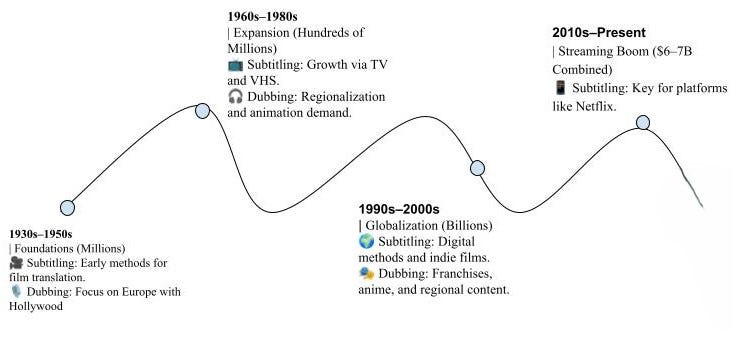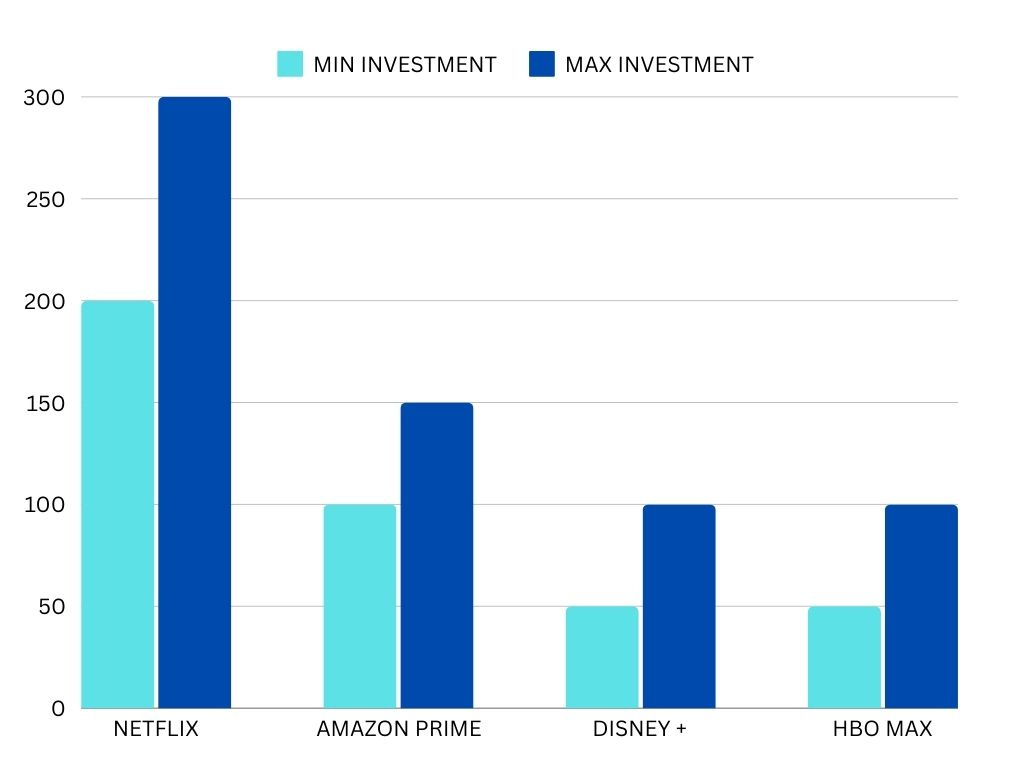The subtitling and dubbing industry, just like a tiny caterpillar crawling through the global gardens, has become a dazzling butterfly owning a billion-dollar global market space with its ability to give wings to the dubbing feature with millions of languages and fluttering across the subtitles on billions of screens. It is an all-new world of boundless entertainment and an immortal industry!
Eggs
The Subdub industry emerged with a simple yet strong idea to serve the people and help them understand the essence of love, drama, culture, and spirituality across nations. The objective of the subdub industry was to break the linguistic barriers while keeping the stories and emotions intact. Back in the silent film days (pre-1927), movies spoke the universal language of exaggerated gestures and dramatic intertitles. Swap out the text cards for any language, and voilà—global distribution! But then The Jazz Singer arrived in 1927 with synchronized sound, and suddenly, audiences needed to understand actual words. Enter subtitles and dubbing, cinema’s dynamic duo.
But why did this emerge? Stories demand to be shared. As global markets expanded and cultural curiosity grew, the need to make content accessible across the world hatched into an essential requirement. It wasn’t just about translating words or scripts—it was about transforming them into experiences that could be universally understood, felt, and connected, no matter the language.
Larva
The most important phase in the life of a butterfly is when it is in the larva stage, similar to the subdub industry. The dubbing and subtitling industry is undergoing a revolution, catalyzed by the explosion of global streaming services and the growing appetite for international content.
One of the largest companies in this industry is SDI Media, a global leader in localization services, including subtitling, dubbing, and voiceover. Other key players are VSI Group, The Kitchen, and Iyuno SDI Group. In 2021, SDI Media was acquired by Iyuno Group, becoming the largest pure-play media localization company, valued at approximately USD 1.2 billion.
If you've ever laughed at a poorly translated subtitle, you know how crucial good localization is. The industry has evolved from literal, awkward translations to capturing humor, cultural references, and idioms that make or break a scene. Have you ever wondered who wrote these subtitles while watching a Japanese movie or anime? In Japan, Studio Ghibli stands out, with a valuation of $22.56 billion in 2022, projected to grow to $42.41 billion by 2029. Other notable players include Toei Animation and TMS Entertainment
Butterfly
Just like when the butterfly adapts to its wings and keeps growing, the industry has been growing. According to the latest research, the global dubbing and subtitling industry was valued at approximately $3.2 billion in 2023 and is projected to grow to $5.1 billion by 2031, with a compound annual growth rate (CAGR) of around 5.9%.
When subtitles go viral, something fun has to happen. For instance, the famous "swarm chittering" line from Stranger Things went viral. Most anime also gained popularity thanks to great subtitling. Netflix reported that its global reach expanded by 50% within just two years of offering multi-language subtitles and dubbing. Over 60% of Netflix's total viewership now comes from international markets, reflecting the global success of its platform.
Case Study
The subdub industry has reached the seventh floor of the sky and all the credit for it goes to giants like Netflix who lifted the subdub industry to such a great height. In 2021, Netflix really went global, dubbing over 5 million minutes of content and subtitling another 7 million—because why should language barriers stop you from watching Stranger Things in your own language? With a content budget surpassing $17 billion in 2023, Netflix is all about making sure everyone, from Tokyo to Tijuana, feels at home on its platform.
Netflix’s Multilingual Strategy:
Netflix has spent a lot in dubbing and providing subtitles to movies and series in many different languages. Netflix, valued at $300 billion in 2024, is eyeing the $1 trillion mark by doing what it does best: hooking 280+ million global subscribers with binge-worthy hits like Bridgerton and Stranger Things. Its ad-supported tiers added 40 million viewers, while clickbait thumbnails, AI recommendations, and viral campaigns (Squid Game, anyone?) keep engagement soaring. For example, the Spanish series MONEY HEIST (La Casa de Papel) became a worldwide sensation gathering millions of people's attention. Since watching something in our language provides us with a sense of belongingness, this personalized experience was ensured by Netflix. This allowed viewers from Tokyo to São Paulo to immerse themselves seamlessly in the story without the barrier of language.
Netflix is absolutely crushing it with over 230 million subscribers, leaving Amazon Prime’s 200 million and Disney+’s 160 million in the dust—sorry, guys! One of Netflix’s secret moves? Speaking your language—literally. Between 2020 and 2021, the viewership of dubbed content shot up by 120%, proving that everyone loves hearing their favorite shows in their own voice.
Parasite’s Oscar Speech: A Tipping Point
One of the most embarking impacts of the sub-dub industry was underlined by Bong Joon-ho when his Korean movie ‘Parasite’ won the Academy Award for Best Picture. It was the very first time that a non-English movie won the Oscar. He said “Once you overcome the one-inch barrier of subtitles, you will be introduced to so many more amazing films”
How Netflix is catering to this?
Netflix has catered to this one-inch difference by normalizing the dubbing and subtitling with its so-called simple funda which is communication understanding.
Increased Accessibility: Almost every Netflix show or movie now comes with a language buffet—dubbed audio for those who’d rather multitask or subtitles for the purists who don’t mind a quick reading workout. Whether you want to hear Tokyo speak fluent English in Money Heist or read her original Spanish sass, Netflix lets you engage your way.
Localized Marketing: Netflix doesn’t just deliver international content—it packages it like your favorite local dish. Whether it’s Squid Game (Korean), Money Heist (Spanish), or Dark (German), they sell it so convincingly that you’ll swear it’s homegrown. By the time you’re hooked, you’re pronouncing “Bella ciao” or “Annyeonghaseyo” like a native.
Quality: Netflix does not cut corners, it makes sure that the voice-over 's voice goes with the actor's face and body language so that the tiger does not get the goat's voice at the climax.
Linguistic nuances? Check. Cultural context? Double check. They don’t just translate—they elevate and make it our favorite.
Netflix Partnership & Investment Strategy:
To make it happen, Netflix gears up with top localization agencies like Iyuno Media Group and ZOO Digital, throws in some AI magic, and keeps its in-house team busy. It’s all part of their plan to make sure you’re hooked on that new hit show, no matter where you are or what language you speak. As when it comes to streaming, Netflix knows: that the more people you can make understand your show, the more people will click "Next Episode." Netflix isn’t exactly stingy when it comes to dubbing and subtitling. The streaming giant drops a cool $200-300 million annually, making sure that the content is accessible worldwide. This ensures shows have subtitles in 30+ languages and dubbing in 10, so whether you're in Paris or Tokyo, you’re good to go. While its competitors like Amazon Prime Video spends around $100-150 million—while Disney+ and HBO Max keep things modest with about $50-100 million each. But hey, with a global empire like Netflix's, it’s no wonder they’re going all in on making sure everyone gets a piece of the content pie in various flavors.
The Impact on the Global Theater
A trend has been started saying Netflix & chill where Netflix is now being used as an acronym for all movies and series of different nations. Suddenly, it’s a competitive market out there. The competition is fierce, with Amazon Prime bundling free shipping, Disney+ flaunting Marvel and Star Wars, and Max delivering award-winning dramas. Regionally, Hotstar owns India with cricket, and Viu hooks Southeast Asia with K-dramas. Netflix stays ahead by mastering subtitles and dubbing, ensuring everyone, everywhere, can tune in. Wherever there’s a couch, Netflix is there.
It’s no exaggeration to say Netflix has rewritten the playbook on global entertainment, turning the world into one big, happy audience and proving that good storytelling speaks every language—even if it comes with a dub or subtitle button.
Desi dialogues: The subdub story
Indians have always been fond of entertainment, from the early days of black-and-white movies like Jodha Akbar to today's HD films available instantly. A whopping 71% of the population prefer subtitles or dubbing in English, making foreign content more relatable. Meanwhile, 23% choose Hindi due to its widespread understanding. Interestingly, 7% prefer content in their mother tongue, with Malayalam (14%) and Tamil (12%) speakers leading this demand.
The dubbing industry in India is a key player in global content consumption, supporting around 50,000 people directly and indirectly, along with jobs in translation, localization, and post-production. If the subdub industry faltered, we would have more unemployed folks than a talent show with no judges!
Conclusion
The dubbing and subtitling are just like twin sisters who are poles apart but their upbringing has been the same. They both come from the same egg i.e. when need came to understand other languages both the ways came up. In the early stages dubbing was more prevalent due to lack of literacy, then a stage came up where people were distinguishing between the two( larva) but now people are fond of subtitling (butterfly). This crazy transformation has both great profits to this industry and it is hoping it will keep growing at the same pace.
References
https://kidscreen.com/2023/06/08/subbing-dubbing-market-to-grow-by-50-in-four-years/
Krewen, N. (2023b, June 8). Subbing & dubbing market to grow by 50% in four years. https://kidscreen.com/2023/06/08/subbing-dubbing-market-to-grow-by-50-in-four-years/#:~:text=Not%20surprisingly%2C%20localization%20requires%20flexibility,that%20those%20things%20are%20continuous.
Bussey, S. (n.d.). The Netflix Effect: A new era of subtitling. https://blog.andovar.com/the-netflix-effect-a-new-era-of-subtitling#:~:text=Netflix%20is%20a%20trailblazer%20when,dared%20competitors%20to%20keep%20up.
Dubbing and subtitling | Encyclopedia.com. (n.d.). https://www.encyclopedia.com/arts/encyclopedias-almanacs-transcripts-and-maps/dubbing-and-subtitling#:~:text=The%20national%20preferences%20for%20subtitled,standing%20of%20the%20films%20themselves.
Reach, L. (2022, April 7). A history of film subtitles and the growth of video translation |. https://www.languagereach.com/a-history-of-film-subtitles-and-the-growth-of-video-translation/
https://www.fool.com/investing/2021/10/25/netflix-could-spend-over-50-billion-on-content/













Amazing Work!